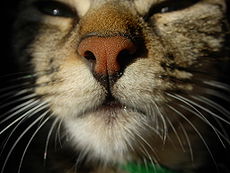Rhinarium


and conspicuous crenellations
The rhinarium (Neo-Latin, "belonging to the nose"; pl.: rhinaria)[1] is the furless skin surface surrounding the external openings of the nostrils in many mammals. Commonly it is referred to as the tip of the snout, and breeders of cats and dogs sometimes use the term nose leather. Informally, it may be called a "truffle", "wet snout," or "wet nose” because its surface is moist in some species: for example, healthy dogs and cats.[2]
In many species, the rhinarium has a mid-line groove (cleft) – the
The study of the rhinarium's structure and associated functions has proven of considerable importance in the fields of mammalian evolution and taxonomy.[5] For example, primates are phylogenetically divided into those, such as lemurs, with the primitive rhinarium (Strepsirrhini) and the dry-nosed primates (Haplorhini, including apes and thus humans).
In an analogous way – entirely unrelated to vertebrate morphology – the term rhinarium is sometimes applied to chemosensory structures in invertebrates. For example, microscopic sensilla in the form of flattened sense organs on the antennae of aphids are referred to as rhinaria.[6]
Morphology
Derivation
But one opposing view traces a path from the philtrum over a notch in the upper lip, through a gap between the first incisors and premaxillae, along a "midline palatal groove" to "a canal that connects with the duct of the vomeronasal organ," suggesting that the rhinarium belongs to the accessory system.[8] It is unclear if moisture (mucus) there functions to trap odiferous molecules — or is the remnant of a fluid transmission system for pheromonal molecules.
Crenellations
Typically, the rhinarium is crenellated (wrinkled, crackled, or embossed), which may, in theory, increase its sensory area, but there are many exceptions and variations among different mammalian taxa, and also variations in the innervation and sensilla of the rhinarium, so such generalized speculation should be treated with caution regarding this matter.[5]
Function
Mammals with rhinaria tend to have a more acute
The rhinarium is adapted for different purposes in different mammals, according to
Evolutionary pressures also are not always unequivocally distinguishable, and there have been upheavals in late 20th and early 21st century taxonomy. For example, the lack of an obvious rhinarium in Tarsiiformes has been interpreted by some scholars as the consequence of the enormous development of the eyeballs, rather than a loss of relevance of olfaction,[10] but the significance is currently debatable, because there currently is an influential body of opinion favouring inclusion of the tarsiers in the Haplorhini rather than in the Strepsirrhini as had been traditional.[11]
Phylogeny
Mammalian
The rhinarium is a general mammalian feature and therefore likely to have been present in the stem mammals.
Primate
). In place of the rhinarium, Haplorhini have a more mobile, continuous, dry upper lip.Use of term in invertebrates
In an analogous usage unrelated to vertebrate morphology, the term rhinarium is sometimes applied to chemosensory structures in invertebrates. For example, microscopic sensilla in the flattened sense organs on the antennae of aphids are referred to as rhinaria.[12]
See also
References
- ^ "rhinarium, -arium". Webster's Third New International Dictionary (Unabridged ed.). Encyclopædia Britannica, Inc. 1986.
- ^ ISBN 9780080469119.
In most mammals we find a moist and shiny glandular area around the nostrils....
- ^ Lund University Faculty of Science Department of Biology Mammalian Rhinarium Group [1]
- ^ Ankel-Simons 2010, pp. 392–514.
- ^ ISBN 978-0126394825
- ^ Du Yongjun Yan Fushun Tang Jue. "Structure and Function of Olfactory Sensilla on the Antennae of Soybean Aphids, Aphis glycines". ACTA Entomologica Sinica 1995, Vol. 38 Issue (1): 1–7 [2]
- ^ Aspinall, Victoria; O'Reilly, Melanie (2004). Introduction to veterinary anatomy and physiology. Edinburgh; New York: Butterworth-Heinemann. p. 98.
The chambers and the turbinates are covered by a ciliated mucous epithelium ... These nerve fibers reach the olfactory bulbs of the forebrain ....
- ^ Smith, Timothy; Rossie, James (2006), "Primate olfaction: anatomy and evolution", in Brewer, Warrick; Castle, David; Pantelis, Christos (eds.), Olfaction and the Brain, Cambridge; New York: Cambridge University Press, p. 139
- ISBN 9789031303229.
- ^ Smith, T. D., & Bhatnagar, K. P. (2004). Microsmatic primates: reconsidering how and when size matters. The Anatomical Record Part B: The New Anatomist, 279(1), 24-31.
- ISBN 978-1-4832-8925-0.
- ^ Du Yongjun Yan Fushun Tang Jue. Structure and Function of Olfactory Sensilla on the Antennae of Soybean Aphids, Aphis glycines. ACTA ENTOMOLOGICA SINICA 1995, Vol. 38 Issue (1): 1-7 [3]
Bibliography
- Fleagle, J. G. (1988). Primate adaptation and evolution. San Diego: Academic Press.
External links
- Mammalian Rhinarium Group - Lund University
